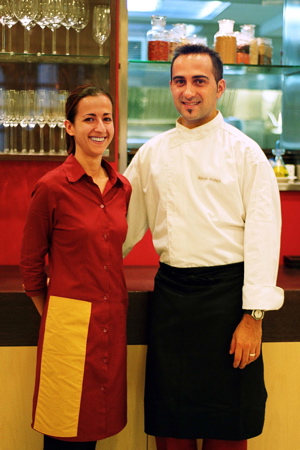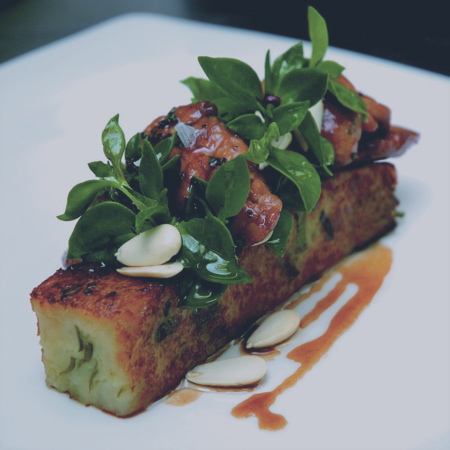
Teresa Parker blogs about restaurants, recipes, and the reasons why she's in love with Spain's food and culture.
 Those Michelin star folks are troublemakers, if you ask me. A couple of years ago, their meddling came between me and my favorite Barcelona lunch date: Restaurant Saüc. It’s not that Saüc’s star wasn’t well-deserved, it’s just that it brought lots of new suitors to the table. Prices went up and our lunchtime thing had to end. We have “La Crisis” to thank for a recent e-mail from the restaurant, wooing with a 27 Euro prix fixe lunch special. The note also mentions a pumpkin salad, beef cheeks with wild mushrooms, almond and pear tart with sheeps’ milk ice cream. You better believe I’ll go running back for more. Chef Xavier Franco cooked in some of the best kitchens in Catalonia, including El Racó de Can Fabes, before he and his wife, Anna Doñate opened Saüc (she’s at the front of the house). The restaurant’s name is an homage to La Cerdanya, the inland mountain region they come from, where saüc – elderberry bush, grows wild. The place is small and simple, almost austere. Franco’s cooking is restrained, too. He likes to combine no more than three or four flavors on the plate, and doesn’t let them get muddled. He’s appealingly brave about putting un-stylish Catalan classics like trinxat (a sort of Catalan bubble and squeak) on the menu. The lunch special is available Tuesdays through Fridays and includes bread, water, coffee, and taxes. The menu changes every two weeks. Saüc, Passatge Lluís Pellicer 12, tel: 93-321-01-89, www.saucrestaurant.com.
Those Michelin star folks are troublemakers, if you ask me. A couple of years ago, their meddling came between me and my favorite Barcelona lunch date: Restaurant Saüc. It’s not that Saüc’s star wasn’t well-deserved, it’s just that it brought lots of new suitors to the table. Prices went up and our lunchtime thing had to end. We have “La Crisis” to thank for a recent e-mail from the restaurant, wooing with a 27 Euro prix fixe lunch special. The note also mentions a pumpkin salad, beef cheeks with wild mushrooms, almond and pear tart with sheeps’ milk ice cream. You better believe I’ll go running back for more. Chef Xavier Franco cooked in some of the best kitchens in Catalonia, including El Racó de Can Fabes, before he and his wife, Anna Doñate opened Saüc (she’s at the front of the house). The restaurant’s name is an homage to La Cerdanya, the inland mountain region they come from, where saüc – elderberry bush, grows wild. The place is small and simple, almost austere. Franco’s cooking is restrained, too. He likes to combine no more than three or four flavors on the plate, and doesn’t let them get muddled. He’s appealingly brave about putting un-stylish Catalan classics like trinxat (a sort of Catalan bubble and squeak) on the menu. The lunch special is available Tuesdays through Fridays and includes bread, water, coffee, and taxes. The menu changes every two weeks. Saüc, Passatge Lluís Pellicer 12, tel: 93-321-01-89, www.saucrestaurant.com.  Trinxat Saüc I asked Xavier Franco for a recipe and was a little taken aback when he offered trinxat. Trinxat has got to be the comfiest winter dish in Catalonia: cabbage and mashed potatoes, flavored with a little garlic and onion and studded with crunchy bits of salty cured tocino (like pancetta). It is something grandmothers make, not chefs. But there’s genius in what Franco’s does here, making the dish more delicate and refined without selling its soul. In his version, the chopped cabbage is replaced by green beans. Sweetbreads rather than bacon provide the meatiness; the onions become a caramelized sauce; a few greens set off the richness of it all. Franco uses lamb sweetbreads, but says veal is fine, too. You do have to think ahead when you make sweetbreads because you may need to get your butcher to order them for you, and because they need to be soaked for a couple of days before they’re cooked. Otherwise, there’s nothing complicated about this dish except the way it conveys rustic satisfaction and luxury at the same time. For 6 people: the sweetbreads 1 lb. lamb or veal sweetbreads flour for dredging salt and pepper 1/4 C olive oil 1 Tbsp. butter 2 Tbsp. minced chives the “trinxat” 3 lbs. red potatoes (or other lower starch potato such as yukon gold), peeled 1 lb. green beans, preferably Italian or Roma, the flatter beans) salt 1/2 C olive oil 3 cloves garlic, peeled and gently smashed the caramelized onion sauce 3 lbs. sweet onions, julienned 1/3 C olive oil 2/3 C beef stock the salad-garnish 3 oz. purslane (or other tart salad greens, such as watercress) 3 Tbsp. almond oil 1 Tbsp. raw almonds (I think toasted and/or sliced would be good, too) prep the sweetbreads Purchase fresh sweetbreads two days ahead of time, cover them in cold water and allow to soak in the refrigerator, changing the water several times (about every 12 hours). Poach gently in salted water for about 8 minutes, until just set, rinse to cool, drain, peel off any excess membrane or fat, and set aside on paper towels until the trinxat is made and you’re ready to finish the dish. (Sweetbreads can be prepped to this point a day ahead and held in the refrigerator). make the “trinxat” Place the peeled potatoes in a pot, cover with cold water, and simmer until tender. Drain and mash potatoes with a fork, leaving them a bit chunky; set aside. Meanwhile, blanch the beans in boiling salted water until just tender, drain and plunge in cold water, then slice crosswise into thin rounds and stir into the smashed potatoes. Heat the 1/2 cup olive oil in a roomy skillet, sizzle the garlic cloves in the oil until they are golden, then remove the garlic and add the potato-bean mixture; without over-blending, let it sizzle, cook off its moisture, and develop brown and crunchy bits. Remove trinxat to a bowl and cool (reserve and strain the oil and use it for making the onion sauce). Trinxat may be made ahead and held in the fridge for a day. make the onion glaze Heat the 1/3 cup olive oil in a large skillet, add sliced onions, and allow to caramelize slowly but thoroughly, stirring occasionally. Keep it slow, tending it while you do other things for at least an hour (Catalan tradition demands nurturing sauce bases like this all damn day). Add the beef stock and simmer to reduce by half. Pour into a strainer and press solids to collect all the onion and beef juices, then discard the solids and return the juices to the pan. Whisk for a glossy sauce consistency. (May also be made ahead and held in the fridge for a day.) finish the dish Have sweetbreads and trinxat at room temperature and warm the onion glaze. Make squared-off rectangular logs of the trinxat (about 6 inches long, 2 inches wide) and brown them lightly on all sides, heating them through. In another skillet, heat butter and oil, slice sweetbreads 1/2 inch thick, dust them with flour, salt and pepper, and fry lightly for just about 2 minutes per side (so they’re crunchy on the outside and creamy in the middle). Wipe out the pan and add about 3/4 of the glaze to coat the sweetbreads. Sprinkle on the minced chives. Dress the purslane with almond oil and toss in the almonds. Plate the browned trinxat with the purslane alongside or on top, then arrange the glazed sweetbreads on the greens and add the almonds. Drizzle each plate with a little of the remaining onion sauce.
Trinxat Saüc I asked Xavier Franco for a recipe and was a little taken aback when he offered trinxat. Trinxat has got to be the comfiest winter dish in Catalonia: cabbage and mashed potatoes, flavored with a little garlic and onion and studded with crunchy bits of salty cured tocino (like pancetta). It is something grandmothers make, not chefs. But there’s genius in what Franco’s does here, making the dish more delicate and refined without selling its soul. In his version, the chopped cabbage is replaced by green beans. Sweetbreads rather than bacon provide the meatiness; the onions become a caramelized sauce; a few greens set off the richness of it all. Franco uses lamb sweetbreads, but says veal is fine, too. You do have to think ahead when you make sweetbreads because you may need to get your butcher to order them for you, and because they need to be soaked for a couple of days before they’re cooked. Otherwise, there’s nothing complicated about this dish except the way it conveys rustic satisfaction and luxury at the same time. For 6 people: the sweetbreads 1 lb. lamb or veal sweetbreads flour for dredging salt and pepper 1/4 C olive oil 1 Tbsp. butter 2 Tbsp. minced chives the “trinxat” 3 lbs. red potatoes (or other lower starch potato such as yukon gold), peeled 1 lb. green beans, preferably Italian or Roma, the flatter beans) salt 1/2 C olive oil 3 cloves garlic, peeled and gently smashed the caramelized onion sauce 3 lbs. sweet onions, julienned 1/3 C olive oil 2/3 C beef stock the salad-garnish 3 oz. purslane (or other tart salad greens, such as watercress) 3 Tbsp. almond oil 1 Tbsp. raw almonds (I think toasted and/or sliced would be good, too) prep the sweetbreads Purchase fresh sweetbreads two days ahead of time, cover them in cold water and allow to soak in the refrigerator, changing the water several times (about every 12 hours). Poach gently in salted water for about 8 minutes, until just set, rinse to cool, drain, peel off any excess membrane or fat, and set aside on paper towels until the trinxat is made and you’re ready to finish the dish. (Sweetbreads can be prepped to this point a day ahead and held in the refrigerator). make the “trinxat” Place the peeled potatoes in a pot, cover with cold water, and simmer until tender. Drain and mash potatoes with a fork, leaving them a bit chunky; set aside. Meanwhile, blanch the beans in boiling salted water until just tender, drain and plunge in cold water, then slice crosswise into thin rounds and stir into the smashed potatoes. Heat the 1/2 cup olive oil in a roomy skillet, sizzle the garlic cloves in the oil until they are golden, then remove the garlic and add the potato-bean mixture; without over-blending, let it sizzle, cook off its moisture, and develop brown and crunchy bits. Remove trinxat to a bowl and cool (reserve and strain the oil and use it for making the onion sauce). Trinxat may be made ahead and held in the fridge for a day. make the onion glaze Heat the 1/3 cup olive oil in a large skillet, add sliced onions, and allow to caramelize slowly but thoroughly, stirring occasionally. Keep it slow, tending it while you do other things for at least an hour (Catalan tradition demands nurturing sauce bases like this all damn day). Add the beef stock and simmer to reduce by half. Pour into a strainer and press solids to collect all the onion and beef juices, then discard the solids and return the juices to the pan. Whisk for a glossy sauce consistency. (May also be made ahead and held in the fridge for a day.) finish the dish Have sweetbreads and trinxat at room temperature and warm the onion glaze. Make squared-off rectangular logs of the trinxat (about 6 inches long, 2 inches wide) and brown them lightly on all sides, heating them through. In another skillet, heat butter and oil, slice sweetbreads 1/2 inch thick, dust them with flour, salt and pepper, and fry lightly for just about 2 minutes per side (so they’re crunchy on the outside and creamy in the middle). Wipe out the pan and add about 3/4 of the glaze to coat the sweetbreads. Sprinkle on the minced chives. Dress the purslane with almond oil and toss in the almonds. Plate the browned trinxat with the purslane alongside or on top, then arrange the glazed sweetbreads on the greens and add the almonds. Drizzle each plate with a little of the remaining onion sauce.Blog Category:
